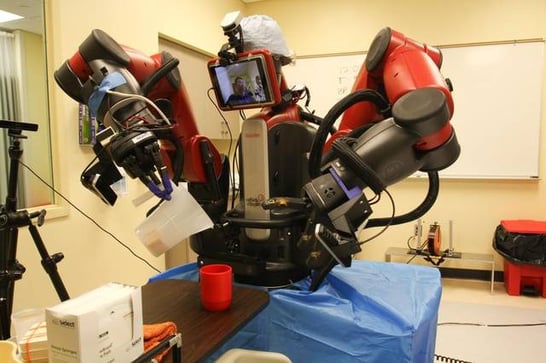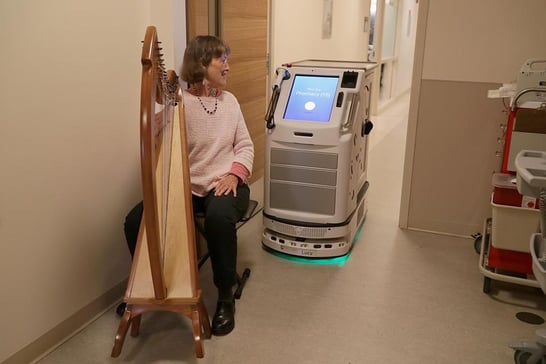 By 2021, robots will have a growing presence in healthcare. That doesn't mean less Nursing positions, but more assistance and safety. Think of robots used to detonate bombs instead of sending in a human to do it. These robots would be dealing with high risk patients with infectious diseases.
By 2021, robots will have a growing presence in healthcare. That doesn't mean less Nursing positions, but more assistance and safety. Think of robots used to detonate bombs instead of sending in a human to do it. These robots would be dealing with high risk patients with infectious diseases. A grant from the National Science Foundation has led engineering and nursing students at Duke University to create a robotic “nurse” to assist human nurses, according to an article published in the News & Observer. The robots are being tested as “alternatives to human contact to diminish risks for providers,” who are caring for patients with infectious diseases.
The first-generation robot called “Trina” (Tele-Robotic Intelligent Nursing Assistant) can perform tasks, albeit clumsily at present, such as delivering a cup, a bowl, pills and a stethoscope to a patient. Its face is a computer screen on which an actual nurse’s face appears.
In the fall, students conducted a simulation with a fake patient using the remote-controlled robot, which has a price tag of $85,000.
Plans for the next generation of Trina include giving her a “more friendly and human-like appearance” and enabling her to collect and test fluids, the article stated.
“We need to establish a better interface with the human and the robot to make them work together and be more comfortable,” Jianqiao Li, engineering student, said in the article.
A Business Wire article stated that by 2021 robots will be a growing presence in the healthcare system, surpassing 10,000 units annually.
“More than 200 companies are already active in various aspects of the healthcare robotics market,” said principal analyst Wendell Chun, in the article. “These industry players are creating highly specialized devices for a wide range of applications, and the use cases will continue to expand as costs decline and healthcare providers recognize the early successes of robots in supporting high-quality care and a range of ancillary services.”
MIT has been teaching robots to assist nurses with scheduling. A robot can observe humans working on a labor and delivery floor and then formulate an efficient schedule for staff, according to the July 2016 MIT News article.
Nurses’ positive comments about the robot included that it would “allow for a more even dispersion of workload” and that it would be helpful to new nurses who are acclimating to their roles.
“A great potential of this technology is that good solutions can be spread more quickly to many hospitals and workplaces,” Dana Kulic, an associate professor of computer engineering at the University of Waterloo, said in the article. “For example, innovative improvements can be distributed rapidly from research hospitals to regional health centers.”
Another robot project funded by the NSF is developing robots to help nurses lift patients and heavy objects.
“The proposed Adaptive Robotic Nurse Assistants will navigate cluttered hospitals, while equipped with multimodal skin sensors that can anticipate nurse intent, automate mundane low-level tasks, but keep nurses in the decision loop,” according to an award abstract. “Modular and strong hardware will be deployed in reconfigurable platforms specially designed for nurse physical assistance.”
Related Article: A Robot Delivers Meds at Dana-Farber



 Technology continues to make strides in both our professional and personal lives. This article is about a robot that’s being tested to deliver medication to chemo patients, thus eliminating the step of having to wait in line for medication after a very lengthy day of chemo. This is a new technology being tested at Dana Farber Cancer Institute and patients are enthusiastic about it.
Technology continues to make strides in both our professional and personal lives. This article is about a robot that’s being tested to deliver medication to chemo patients, thus eliminating the step of having to wait in line for medication after a very lengthy day of chemo. This is a new technology being tested at Dana Farber Cancer Institute and patients are enthusiastic about it.

